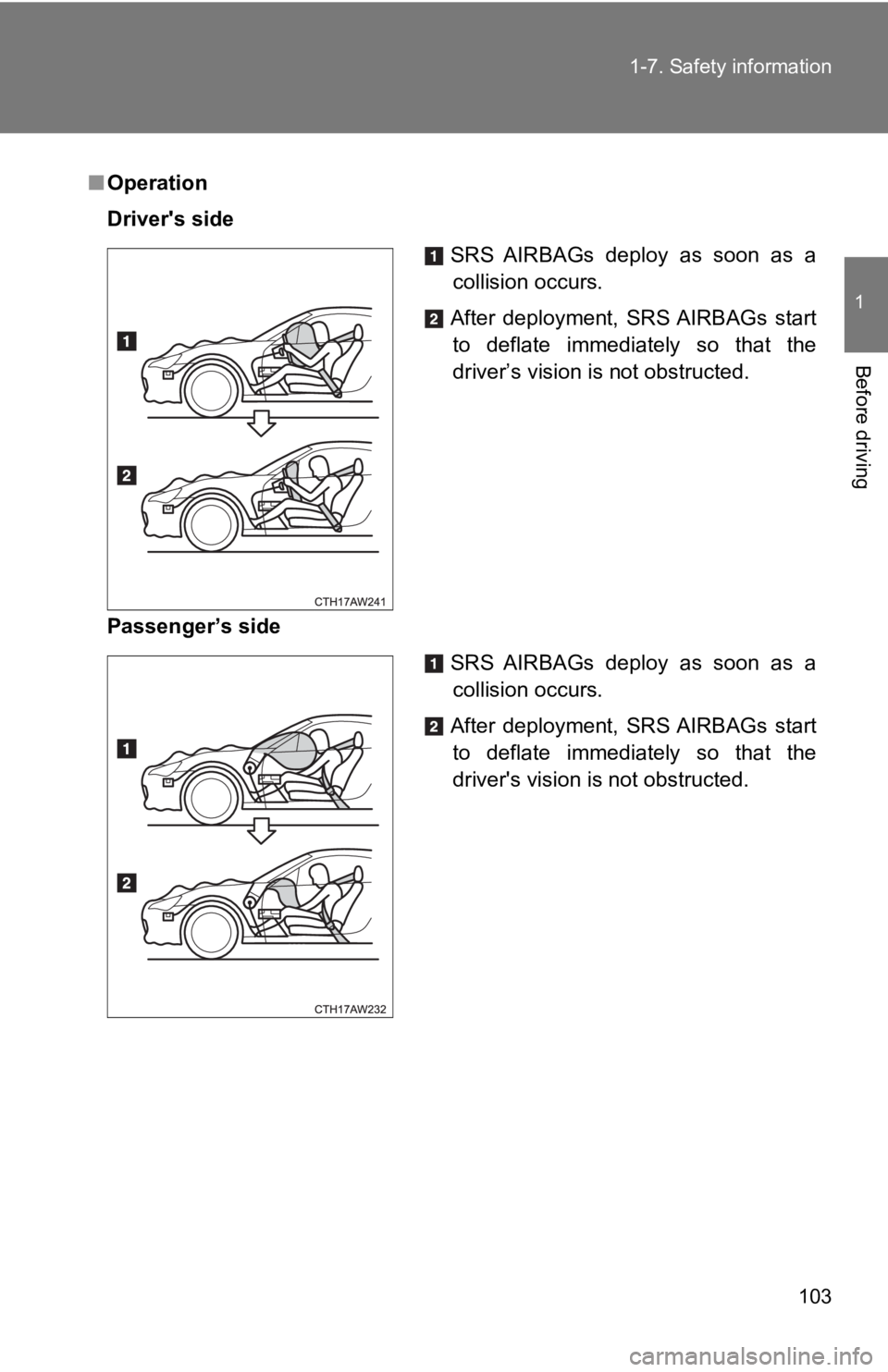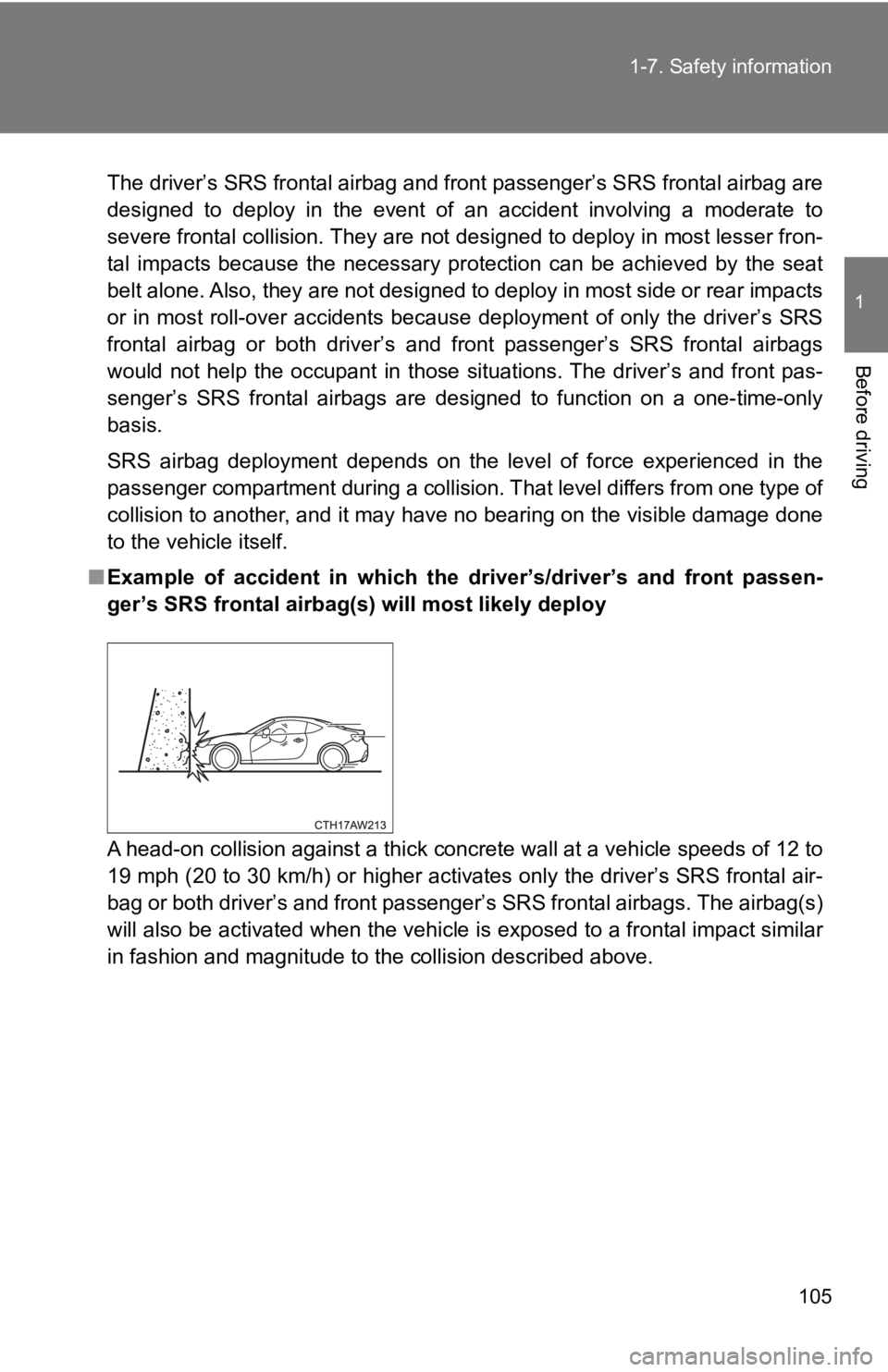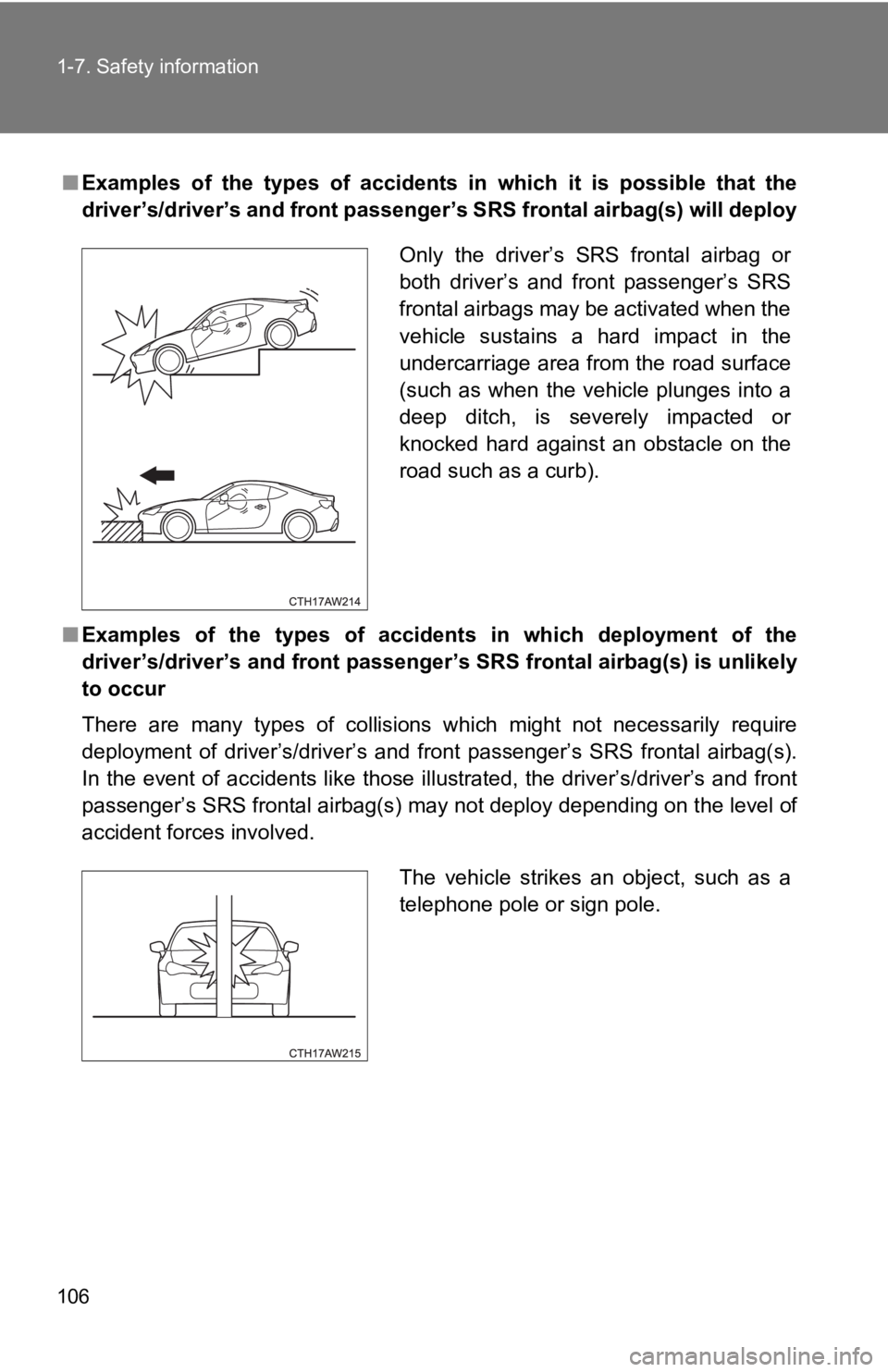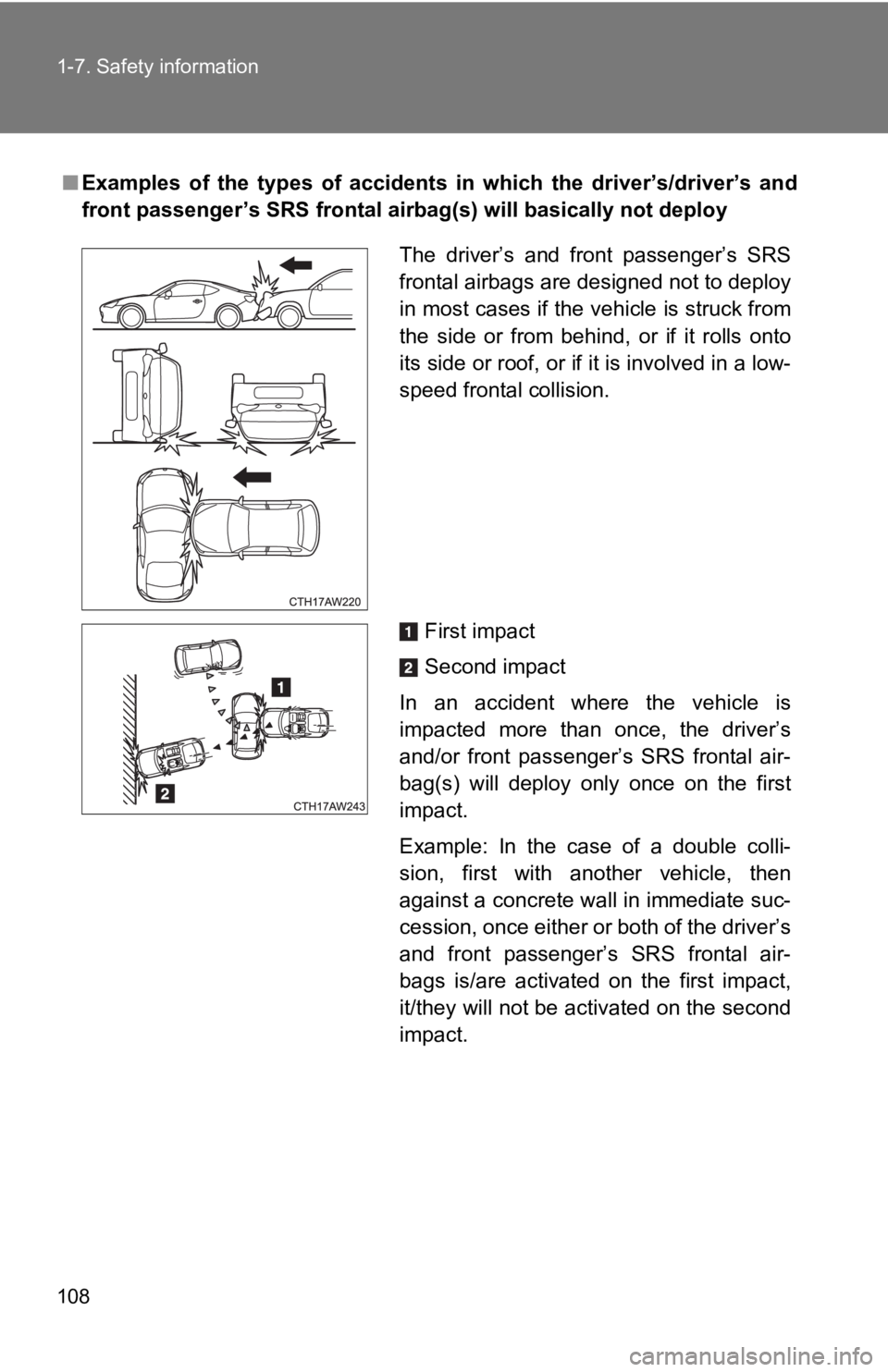airbag TOYOTA 86 2020 Owner's Manual
[x] Cancel search | Manufacturer: TOYOTA, Model Year: 2020, Model line: 86, Model: TOYOTA 86 2020Pages: 532, PDF Size: 8 MB
Page 99 of 532

99
1-7. Safety information
1
Before driving
Also, if luggage or electronic devices are placed on the front
passenger’s
seat, this may adversely affect the ability of the system to determine deploy-
ment. This may prevent the front passenger’s frontal airbag ON and OFF
indicators from working properly. Check that the indicators wor k properly.
When the OFF indicator turns off and the ON indicator illuminat es, the front
passenger’s frontal airbag may deploy during a collision. Remov e luggage
and electronic devices from the front passenger’s seat.
NOTE
This device complies with Part 18 of the FCC Rules. This device may cause
interference. If this device causes interference, consult the n earest Toyota
dealer. Also, for maintenance of the system, consult the neares t Toyota
dealer.
■ Conditions in which front passen ger’s SRS frontal airbag is not acti-
vated
The front passenger’s SRS frontal airbag will not be activated when any of
the following conditions are met regarding the front passenger’s seat:
● The seat is empty.
● The seat is equipped with an appropriate child restraint system and an
infant is restrained in it.
● The occupant changed their posture after the occupant load is j udged.
● The front passenger’s occupant classification system is malfunctioning.
WARNING
When the front passenger’s seat is occupied by an infant in an appropriate
child restraint system, observe the following precautions. Fail ure to do so may
interfere with the proper operation of the occupant classification system, acti-
vating the front passenger’s SRS frontal airbag even though tha t seat is occu-
pied by the infant in the child restraint system.
● Do not place any article (including electronic devices) on the seat other than
the infant in the child restraint system.
● Do not place more than one infant in the child restraint system.
Page 100 of 532

100 1-7. Safety information
■If the front passenger’s frontal a irbag ON indicator illuminates and the
OFF indicator turns off even when an infant or a small child is in a child
restraint system (incl uding booster seat)
Turn the engine switch to the “LOCK” position (vehicles without a smart key
system), or turn the “ENGINE START STOP” switch off (vehicles w ith a
smart key system) if the front passenger’s frontal airbag ON in dicator illumi-
nates and the OFF indicator turns off even when an infant or a small child is
in a child restraint system (including booster seat). Remove th e child
restraint system from the seat. By referring to the child restraint manufac-
turer’s recommendations as well as the child restraint system installation
procedures in “Child restraint systems” ( P. 137), correctly install the child
restraint system. Turn the engine switch to the “ON” position ( vehicles with-
out a smart key system), or turn the “ENGINE START STOP” switch to IGNI-
TION ON mode (vehicles with a smart key system) and make sure that the
front passenger’s frontal airbag ON indicator turns off and the OFF indicator
illuminates.
If still the ON indicator remains illuminated while the OFF ind icator turns off,
take the following actions.
● Ensure that no article is placed on the seat other than the chi ld restraint
system and the child occupant.
● Ensure that the backward-forward position and seatback of front passen-
ger’s seat are locked into place securely by moving the seat back and
forth.
If the ON indicator still remains illuminated while the OFF indicator turns off
after taking relevant corrective actions described above, reloc ate the child
restraint system to the rear seat and immediately contact your Toyota dealer
for an inspection.
NOTE
When a child who has outgrown a child restraint system or a sma ll adult is
seated in the front passenger’s seat, the Toyota advanced front al airbag sys-
tem may or may not activate the front passenger’s SRS frontal a irbag
depending on the occupant’s seating posture. The child should a lways wear
the seat belt when sitting in the seat irrespective of whether the airbag is
deactivated or activated. If the front passenger’s SRS frontal airbag is acti-
vated (the ON indicator remains illuminated while the OFF indic ator turns
off), take the following actions.
Page 101 of 532

101
1-7. Safety information
1
Before driving
●
Ensure that no article is placed on the seat other than the occupant.
If the ON indicator still remains illuminated while the OFF indicator turns off
despite the fact that the actions noted above have been taken, seat the
child/small adult in the rear seat and immediately contact your Toyota dealer
for an inspection. Even if the system has passed the dealer ins pection, it is
recommended that on subsequent trips the child/small adult alwa ys take the
rear seat.
Children who have outgrown a child restraint system should alwa ys wear the
seat belt irrespective of whether the airbag is deactivated or activated.
■ Conditions in which fr ont passenger’s SRS frontal airbag is activated
The front passenger’s SRS frontal airbag will be activated for deployment
upon impact when any of the following conditions are met regard ing the front
passenger’s seat.
● When the seat is occupied by an adult.
● When a certain item(s) (e.g. jug of water) is placed on the seat.
Page 102 of 532

102 1-7. Safety information
■If the passenger’s frontal airbag OFF indicator illuminates and the ON
indicator turns off even when the front passenger’s seat is occ upied by
an adult
This can be caused by the adult incorrectly sitting in the fron t passenger’s
seat. Turn the engine switch to the “LOCK” position (vehicles w ithout a smart
key system), or turn the “ENGINE START STOP” switch off (vehicl es with a
smart key system). Ask the front passenger to set the seatback to the
upright position, sit up straight in the center of the seat cushion, correctly
fasten the seat belt, position his/her legs out forward, and ad just the seat to
the rearmost position. Turn the engine switch to the “ON” posit ion (vehicles
without a smart key system), or turn the “ENGINE START STOP” sw itch to
IGNITION ON mode (vehicles with a smart key system). If the OFF indicator
remains illuminated while the ON indicator remains off, take th e following
actions.
● Vehicles without a smart key system:
Turn the engine switch to the “LOCK” position.
Vehicles with a smart key system:
Turn the “ENGINE START STOP” switch off.
● Make sure that the front passenger does not use a blanket, seat cushion,
seat cover, seat heater or massager, etc.
● If wearing excessive layers of clothing, the front passenger should
remove any unnecessary items before sitting in the front passenger’s
seat, or should sit in a rear seat.
● Next, turn the engine switch to the “ON” position and wait 6 se conds to
allow the system to complete self-checking. Following the syste m check,
both indicators turn off for 2 seconds. Now, the ON indicator should illu-
minate while the OFF indicator remains off.
If the OFF indicator still remains illuminated while the ON ind icator remains
off, ask the occupant to move to the rear seat and immediately contact your
Toyota dealer for an inspection.
Page 103 of 532

103
1-7. Safety information
1
Before driving
■
Operation
Driver's side
Passenger’s side
SRS AIRBAGs deploy as soon as a
collision occurs.
After deployment, SRS AIRBAGs start to deflate immediately so that the
driver’s vision is not obstructed.
SRS AIRBAGs deploy as soon as acollision occurs.
After deployment, SRS AIRBAGs start to deflate immediately so that the
driver's vision is not obstructed.
Page 104 of 532

104 1-7. Safety information
The SRS airbag can function only when the engine switch is in the “ON”
position (vehicles without a smart key system) or when the “ENGINE START
STOP” switch is in IGNITION ON mode (vehicles with a smart key system).
The Toyota advanced frontal airbag system is designed to determ ine the
activation or deactivation condition of the front passenger’s S RS frontal air-
bag depending on the characteristic of the item(s) or person on the front
passenger’s seat monitored by the front passenger’s occupant cl assification
system sensor. For this reason, only the driver’s SRS frontal a irbag may
deploy in the event of a collision, but this does not mean fail ure of the sys-
tem.
If the front sub sensors and the impact sensors in the airbag c ontrol module
detect a predetermined amount of force during a frontal collisi on, the control
module sends signals to the airbag module(s) (only driver’s mod ule or both
driver’s and front passenger’s modules) instructing the module( s) to inflate
the SRS frontal airbag(s).
The driver’s and front passenger’s SRS frontal airbags use dual stage infla-
tors. The two inflators of each airbag are triggered either seq uentially or
simultaneously, depending on the severity of impact, in the cas e of the
driver’s SRS frontal airbag and depending on the severity of im pact and the
characteristic of the item(s) or person on the seat in the case of the front
passenger’s SRS frontal airbag.
After deployment, the SRS airbag immediately starts to deflate so that the
driver’s vision is not obstructed. The time required from detec ting impact to
the deflation of the SRS airbag after deployment is shorter tha n the blink of
an eye.
Both when only the driver’s SRS frontal airbag deploys and the driver’s and
front passenger’s SRS frontal airbags deploy, the driver’s and front passen-
ger’s seat belt pretensioners operate at the same time.
Although it is highly unlikely that the SRS airbag would activa te in a non-
accident situation, should it occur, the SRS airbag will deflat e quickly, not
obscuring vision and will not interfere with the driver's abili ty to maintain con-
trol of the vehicle.
When the SRS airbag deploys, a sudden, fairly loud inflation no ise will be
heard and some smoke will be released. These occurrences are a normal
result of the deployment. This smoke does not indicate a fire i n the vehicle.
Page 105 of 532

105
1-7. Safety information
1
Before driving
The driver’s SRS frontal airbag and front passenger’s SRS frontal airbag are
designed to deploy in the event of an accident involving a mode rate to
severe frontal collision. They are not designed to deploy in most lesser fron-
tal impacts because the necessary protection can be achieved by the seat
belt alone. Also, they are not designed to deploy in most side or rear impacts
or in most roll-over accidents because deployment of only the d river’s SRS
frontal airbag or both driver’s and front passenger’s SRS frontal airbags
would not help the occupant in those situations. The driver’s and front pas-
senger’s SRS frontal airbags are designed to function on a one- time-only
basis.
SRS airbag deployment depends on the level of force experienced in the
passenger compartment during a collision. That level differs fr om one type of
collision to another, and it may have no bearing on the visible damage done
to the vehicle itself.
■ Example of accident in which the driver’s/driver’s and front passen-
ger’s SRS frontal airbag(s) will most likely deploy
A head-on collision against a thick concrete wall at a vehicle speeds of 12 to
19 mph (20 to 30 km/h) or higher activates only the driver’s SR S frontal air-
bag or both driver’s and front passenger’s SRS frontal airbags. The airbag(s)
will also be activated when the vehicle is exposed to a frontal impact similar
in fashion and magnitude to the collision described above.
Page 106 of 532

106 1-7. Safety information
■Examples of the types of accidents in which it is possible that the
driver’s/driver’s and front passenger’s SRS frontal airbag(s) w ill deploy
■ Examples of the types of accidents in which deployment of the
driver’s/driver’s and front passe nger’s SRS frontal airbag(s) is unlikely
to occur
There are many types of collisions which might not necessarily require
deployment of driver’s/driver’s and front passenger’s SRS front al airbag(s).
In the event of accidents like those illustrated, the driver’s/driver’s and front
passenger’s SRS frontal airbag(s) may not deploy depending on t he level of
accident forces involved.
Only the driver’s SRS frontal airbag or
both driver’s and front passenger’s SRS
frontal airbags may be activated when the
vehicle sustains a hard impact in the
undercarriage area from the road surface
(such as when the vehicle plunges into a
deep ditch, is severely impacted or
knocked hard against an obstacle on the
road such as a curb).
The vehicle strikes an object, such as a
telephone pole or sign pole.
Page 108 of 532

108 1-7. Safety information
■Examples of the types of accidents in which the driver’s/driver ’s and
front passenger’s SRS frontal airbag(s) will basically not deploy
The driver’s and front passenger’s SRS
frontal airbags are designed not to deploy
in most cases if the vehicle is struck from
the side or from behind, or if it rolls onto
its side or roof, or if it is involved in a low-
speed frontal collision.
First impact
Second impact
In an accident where the vehicle is
impacted more than once, the driver’s
and/or front passenger’s SRS frontal air-
bag(s) will deploy only once on the first
impact.
Example: In the case of a double colli-
sion, first with another vehicle, then
against a concrete wall in immediate suc-
cession, once either or both of the driver’s
and front passenger’s SRS frontal air-
bags is/are activated on the first impact,
it/they will not be activated on the second
impact.
Page 109 of 532

109
1-7. Safety information
1
Before driving
WARNING
■
If the SRS airbags deploy
Do not touch the SRS airbag system components around the steeri ng wheel
and dashboard with bare hands right after deployment. Doing so can cause
burns because the components can be very hot as a result of dep loyment.
■ Child restraint precautions
NEVER INSTALL A REARWARD FACING CHILD SEAT IN THE FRONT
PASSENGER’S SEAT EVEN IF THE FRONT PASSENGER’S SRS FRON-
TAL AIRBAG IS DEACTIVATED. Be sure to install it in the REAR se at in a
correct manner. Also, it is strongly recommended that any forwa rd facing
child seat or booster seat be installed in the REAR seat, and t hat even chil-
dren who have outgrown a child restraint system be also seated in the
REAR seat. This is because children sitting in the front passen ger’s seat
may be killed or severely injured should the front passenger’s SRS frontal
airbag deploy. REAR seats are the safest place for children.